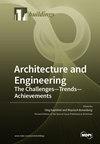Flexural Behavior of Galvanized Iron Based Cold-Formed Steel Back-to-Back Built-Up Beams at Elevated Temperatures
IF 3.1
3区 工程技术
Q2 CONSTRUCTION & BUILDING TECHNOLOGY
引用次数: 0
Abstract
Cold-formed steel (CFS) sections have become popular in construction due to several advantages over structural steel. However, research on the performance of galvanized iron (GI)-based CFS under high temperatures, especially regarding its flexural behavior, has been limited. This study extensively investigates how GI-based CFS beams with varying spans behave under elevated temperatures and subsequent cooling using air and water. This study examines the impact of temperature loading and compares the effectiveness of air- and water-cooling methods. Experimental results are validated and analyzed alongside findings from finite element modeling (FEM) using ABAQUS (2019_09_13-23.19.31) and the Direct Strength Method (DSM). Additionally, this study conducts a parametric investigation to assess how beam span influences flexural capacity. Among beams heated to the same temperature, those cooled with water show slightly lower load capacities compared to those cooled with air. The highest load capacity observed is 64.3 kN for the reference specimen, while the lowest is 26.2 kN for the specimen heated for 90 min and cooled with water, a 59.27% difference between them. Stiffness decreases as heating duration increases, with the reference section exhibiting significantly higher stiffness compared to the section heated for 90 min and cooled with water, with a 92.76% difference in stiffness. As heating duration increases, ductility also increases. Various failure modes are observed based on different heating and cooling conditions across different beam spans. This study provides insights into how GI-based CFS beams perform under temperature stress and different cooling scenarios, contributing valuable data for structural design and safety considerations in construction.高温条件下镀锌铁基冷弯型钢背靠背组合梁的挠曲性能
与结构钢相比,冷弯型钢(CFS)具有多种优点,因此在建筑领域很受欢迎。然而,对镀锌铁(GI)冷弯型钢在高温下的性能,尤其是弯曲性能的研究还很有限。本研究广泛调查了不同跨度的镀锌铁基 CFS 梁在高温及随后使用空气和水冷却的情况下的表现。本研究探讨了温度加载的影响,并比较了空气冷却和水冷却方法的有效性。实验结果与使用 ABAQUS (2019_09_13-23.19.31) 和直接强度法 (DSM) 进行有限元建模 (FEM) 的结果进行了验证和分析。此外,本研究还进行了参数调查,以评估梁跨度如何影响抗弯能力。在加热到相同温度的梁中,用水冷却的梁的承载能力略低于用空气冷却的梁。参考试样的最高承载能力为 64.3 千牛,而加热 90 分钟并用水冷却的试样的最低承载能力为 26.2 千牛,两者相差 59.27%。刚度随着加热时间的延长而降低,与加热 90 分钟并用水冷却的试样相比,参考试样的刚度明显更高,刚度差为 92.76%。随着加热时间的延长,延展性也在增加。根据不同梁跨的不同加热和冷却条件,可观察到各种失效模式。这项研究深入揭示了基于 GI 的 CFS 梁在温度应力和不同冷却情况下的性能,为建筑结构设计和安全考虑提供了宝贵的数据。
本文章由计算机程序翻译,如有差异,请以英文原文为准。
求助全文
约1分钟内获得全文
求助全文
来源期刊

Buildings
Multiple-
CiteScore
3.40
自引率
26.30%
发文量
1883
审稿时长
11 weeks
期刊介绍:
BUILDINGS content is primarily staff-written and submitted information is evaluated by the editors for its value to the audience. Such information may be used in articles with appropriate attribution to the source. The editorial staff considers information on the following topics: -Issues directed at building owners and facility managers in North America -Issues relevant to existing buildings, including retrofits, maintenance and modernization -Solution-based content, such as tips and tricks -New construction but only with an eye to issues involving maintenance and operation We generally do not review the following topics because these are not relevant to our readers: -Information on the residential market with the exception of multifamily buildings -International news unrelated to the North American market -Real estate market updates or construction updates
 求助内容:
求助内容: 应助结果提醒方式:
应助结果提醒方式:


